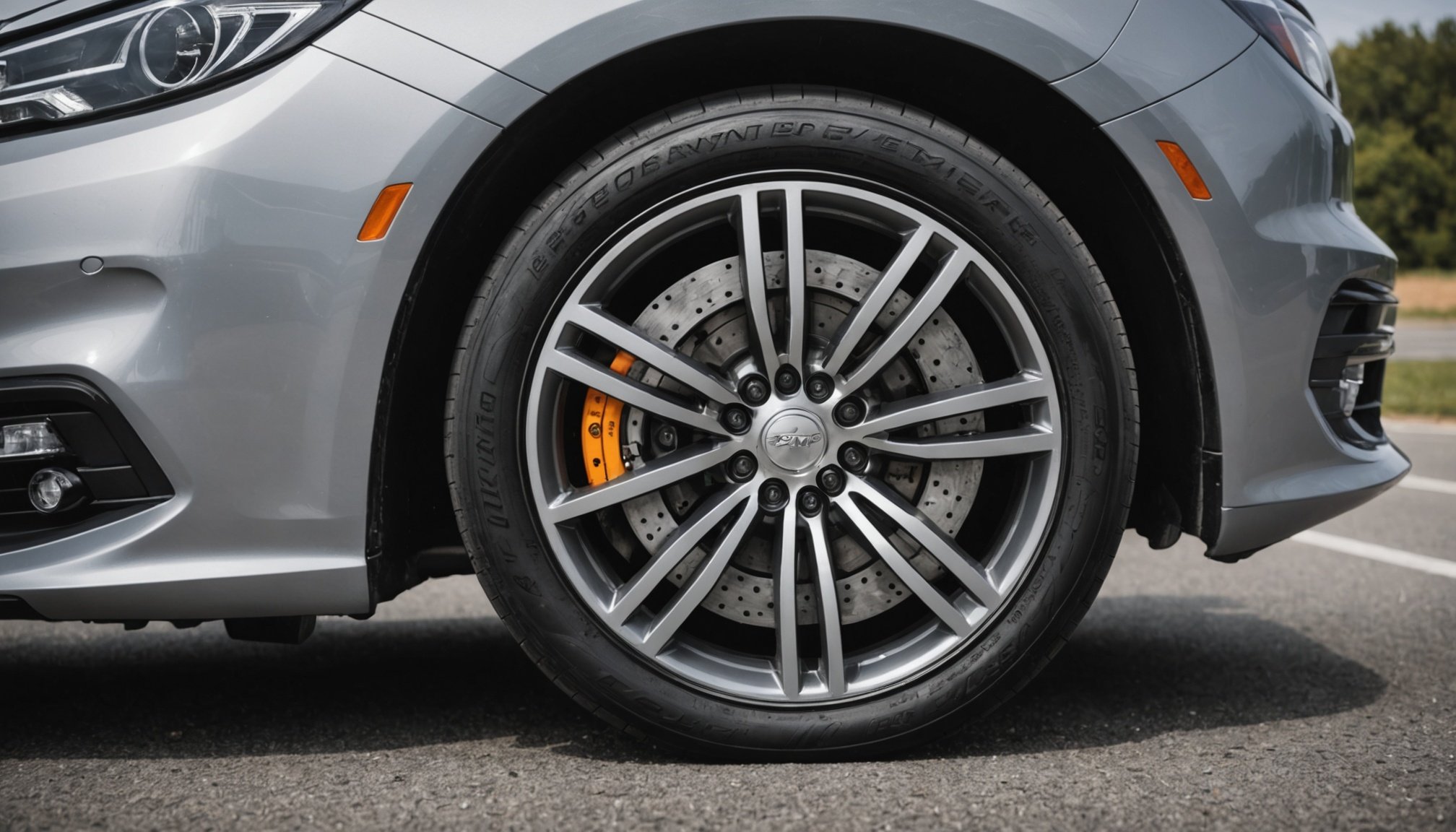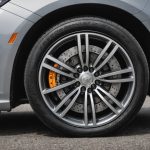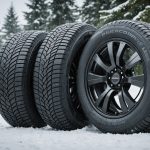Unveiling the Effects of Ambient Temperature on Tire Pressure: Essential Insights for Every Driver’s Safety
Understanding the Importance of Tire Pressure
When it comes to vehicle safety, one of the most often overlooked yet critical aspects is tire pressure. Maintaining the correct tire pressure is not just about ensuring your vehicle runs smoothly; it is also crucial for safety, fuel efficiency, and the overall driving experience. Here’s why tire pressure should be at the top of your vehicle maintenance checklist.
Tire pressure is the air within the tires, measured in pounds per square inch (PSI). The recommended PSI can be found on a sticker affixed to the driver-side door jamb, in the glove box, or on the inside of the fuel-filler door, as well as in the owner’s manual[1][2][5].
Also to see : Top strategies for guaranteeing your vehicle”s electronic parking brake safety and dependability
Correct tire pressure helps distribute the vehicle’s weight evenly across the tires, improving stability and safety. It prevents premature wear and tear, saving you money in the long run. On the other hand, incorrect tire pressure can lead to serious issues such as uneven wear, reduced traction, and increased risk of a blowout. For instance, over-inflated tires may wear out faster in the center, while under-inflated tires create more friction, which increases the risk of overheating or a blowout[2].
How Temperature Affects Tire Pressure
One of the key factors that influence tire pressure is ambient temperature. The relationship between temperature and tire pressure is governed by the Ideal Gas Law, which states that gas volume and pressure decrease as temperature drops.
The Physics Behind It
When the temperature drops, the air inside the tires contracts, leading to a decrease in tire pressure. For every 10°F (about 5.5°C) drop in ambient temperature, tire pressure can decrease by approximately 1 PSI. This might seem like a small reduction, but it can have significant implications for vehicle performance and safety[3][5].
Practical Implications
- Cold Weather: During the winter months, the drop in temperature can cause tires to lose about 1-2 PSI for every 10°F drop. This can result in poor handling, reduced fuel efficiency, and accelerated tire wear. For example, if your tires were last checked and inflated in the summer, they could easily lose 7-10 PSI by the time winter arrives[1][3].
- Warm Weather: Conversely, as the weather warms up, the air inside the tires expands, increasing the pressure. Tires properly inflated in the winter can be running too high a pressure as the weather warms, so some air should be let out to drop them to the proper pressure[1].
Checking and Adjusting Tire Pressure
Given the impact of temperature on tire pressure, it is essential to check and adjust your tire pressure regularly.
Best Practices for Checking Tire Pressure
- Check When Cold: Tire pressure should be checked when the tires are cold, preferably in the morning after the vehicle has been sitting overnight. Driving the car will heat up the tires due to friction with the road, and sun shining on the tires can also heat them up, giving a false high reading[1][5].
- Use a Reliable Gauge: Use a reliable tire pressure gauge to ensure accurate readings. You can find these gauges at most gas stations or auto repair shops.
- Compare to Manufacturer’s Recommendation: Refer to your vehicle’s manual or the sticker inside the driver’s door jamb for the recommended PSI. Adjust the pressure as needed to match this recommendation[1][5].
How Often to Check
- Monthly Checks: The common rule is to check your tire pressures once a month. However, this may not be enough, especially during extreme weather changes. It’s advisable to check tire pressure weekly during cold spells or before long trips[1][3].
- Visual Checks: Perform a visual check every time you approach the car. Compare the ground contact patch on the front tire to the rear on the same side to see if one looks low. Although this method is less noticeable with modern low-profile tires, it can still provide valuable insights[1].
Signs of Improper Tire Pressure
Recognizing the signs of improper tire pressure can help you take corrective action before it becomes a safety issue.
Common Signs
- Uneven or Excessive Wear: If your tires are wearing unevenly or excessively, it could be a sign of incorrect tire pressure.
- Vibration While Driving: Vibration while driving can indicate that your tires are not properly inflated.
- Pulling Sensation When Steering: A pulling sensation when steering suggests that your tire pressure might be off[2].
The Dangers of Underinflated Tires
Underinflated tires pose significant risks to vehicle safety and performance.
Reduced Traction
Underinflated tires have a larger contact area with the road, which might seem like an advantage in icy conditions but actually leads to reduced traction. This can increase the risk of slipping or sliding on slick surfaces[3].
Increased Wear
When tire pressure is too low, the tires wear unevenly, leading to faster degradation of the tire’s sidewalls and edges. This can result in a blowout or the need for premature tire replacement[3].
Poor Fuel Efficiency
Low tire pressure increases rolling resistance, causing the engine to work harder to move the car. This leads to lower fuel efficiency and increased wear on engine components[3].
Tips for Managing Tire Pressure in Various Conditions
Here are some practical tips to help you manage tire pressure effectively in different weather conditions:
Cold Weather Tips
- Check Tire Pressure Weekly: During extreme cold spells, check your tire pressure weekly to ensure it remains at the recommended level.
- Inflate Slightly Higher: Some drivers prefer inflating their tires slightly above the recommended PSI to counteract the pressure drop. However, be cautious not to exceed the maximum pressure indicated on the tire sidewall[5].
- Monitor All Tires: Don’t forget to check the spare tire. It’s essential to ensure that it’s properly inflated in case of emergencies[5].
Warm Weather Tips
- Adjust for Temperature Changes: As the weather warms up, check your tire pressure regularly to ensure it doesn’t exceed the recommended level.
- Use Nitrogen: Nitrogen expands and contracts less with temperature changes compared to regular air, making it a good option for maintaining more consistent tire pressure in extreme climates[3].
Technology to Help Monitor Tire Pressure
Modern vehicles often come equipped with technology designed to help monitor and maintain proper tire pressure.
Tire Pressure Monitoring System (TPMS)
- Warning Light: The TPMS warning light, which typically looks like a “U” with an exclamation point in the center, illuminates on the instrument panel when the tires are determined to be 25% below their recommended pressures. This is a critical safety feature that alerts you to potential issues before they become severe[1].
- Real-Time Monitoring: Some advanced TPMS systems provide real-time monitoring of tire pressure, allowing you to adjust the pressure as needed without waiting for a warning light to come on. and Practical Advice
Maintaining the correct tire pressure is a simple yet crucial step in ensuring vehicle safety and performance. Here are some key takeaways and practical advice:
Key Takeaways
- Temperature Impact: Temperature changes significantly affect tire pressure, with a drop of about 1 PSI for every 10°F decrease in temperature.
- Regular Checks: Check your tire pressure regularly, especially during extreme weather changes.
- Use Reliable Tools: Use a reliable tire pressure gauge and refer to the manufacturer’s recommended PSI.
- Monitor All Tires: Ensure all tires, including the spare, are properly inflated.
Practical Advice
- Carry a Tire Pressure Gauge: Always carry a tire pressure gauge in your car for convenience.
- Adjust for Load: Adjust your PSI based on the load you’re carrying, especially if transporting heavy items.
- Inspect Tires: Regularly inspect your tires for visible signs of wear, such as cracks or bulges[2].
By following these guidelines and staying proactive about maintaining your tire pressure, you can significantly enhance your vehicle’s safety, fuel efficiency, and overall driving experience.
Table: Comparing the Effects of Temperature on Tire Pressure
| Temperature Change | Effect on Tire Pressure | Potential Risks |
|---|---|---|
| 10°F Drop | 1-2 PSI Decrease | Reduced traction, increased wear, poor fuel efficiency[3][5] |
| 10°F Increase | 1-2 PSI Increase | Over-inflation, reduced traction, uneven wear[1][2] |
| Extreme Cold | Significant Pressure Drop | Poor handling, increased risk of blowout[3][5] |
| Extreme Heat | Significant Pressure Increase | Over-inflation, reduced fuel efficiency[1][2] |
Detailed Bullet Point List: Signs and Consequences of Improper Tire Pressure
-
Uneven or Excessive Wear:
-
Premature wear on the center or edges of the tire.
-
Increased risk of tire failure.
-
Higher maintenance costs.
-
Vibration While Driving:
-
Uncomfortable driving experience.
-
Potential damage to vehicle components.
-
Reduced vehicle stability.
-
Pulling Sensation When Steering:
-
Difficulty in maintaining a straight course.
-
Increased risk of accidents.
-
Reduced vehicle control.
-
Reduced Traction:
-
Increased risk of slipping or sliding on slick surfaces.
-
Poor handling in emergency maneuvers.
-
Reduced safety in adverse weather conditions.
-
Increased Wear:
-
Faster degradation of tire sidewalls and edges.
-
Increased risk of tire blowout.
-
Higher maintenance costs.
-
Poor Fuel Efficiency:
-
Increased rolling resistance.
-
Higher fuel consumption.
-
Increased wear on engine components.
By understanding and addressing these issues, you can ensure a safer and more efficient driving experience.
Quotes and Insights from Experts
- “Tire pressure might not always grab your attention, but it plays a crucial role in keeping your vehicle running smoothly, safely, and efficiently.” – Miller Bros Auto Repair[2]
- “For every 10°F drop in ambient temperature, tire pressure can decrease by approximately 1 PSI.” – Boardwalk Auto Group[5]
- “Underinflated tires have a larger contact area with the road, which might seem like an advantage in icy conditions but actually leads to reduced traction.” – AmeriFreight[3]
These insights highlight the critical importance of monitoring and adjusting tire pressure in response to temperature changes, ensuring a safer and more efficient driving experience for all.











